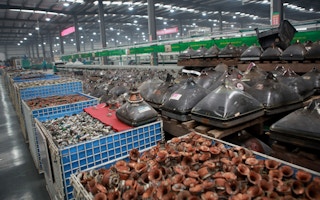Some things we’re glad to see grow: trees, children, our bank account balance, goodwill. But other things, not so much.
One of those “other things” is e-waste — outdated computers, broken cellphones, old appliances and other electronic castoffs of 21st-century life. According to the just-released Global E-waste Monitor 2020, last year people around the world generated 53.6 million metric tonnes (59.1 million tonnes) of e-waste — the equivalent of 9 million full-grown African elephants. That figure represents a 21 per cent growth since 2014. The largest category of waste was small equipment, including microwaves, calculators, electronic toys and video cameras.
The report, an update on similar studies published in 2015 and 2017, was released July 2 by the Sustainable Cycles Programme, an initiative of the United Nations University, the UN Institute for Training and Research, the International Telecommunication Union, and the International Solid Waste Association. Interestingly, the e-waste generated in 2019 already exceeds the 52.2 million metric tonnes (57.5 million tonnes) the 2017 report projected for 2021.
According to the report, documented e-waste recycling also increased between 2014 and 2019, from 7.5 million metric tonnes (8.3 million tonnes) to 9.3 million metric tonnes (10.3 million tonnes). About 17.4 per cent of the discards were known to be recycled last year, compared with 17 per cent in 2014. “The recycling activities are not keeping pace with the global growth of e-waste,” the report says.
Trashing e-waste is a problem for many reasons. It adds bulk and toxic substances to already brimming landfills. It can contaminate air and water and pose health risks for people. It contributes to the climate crisis both in the form of fossil fuel energy required to produce and handle it and in greenhouse gases released, the report says.
Not only that, but it also represents a waste of valuable raw materials, including copper, silver, gold and platinum. The report estimates that the raw materials embodied in e-waste generated in 2019 alone are worth some US$57 billion.
What to do? At the global level, the report recommends reducing the production of e-waste, improving recycling, preventing inappropriate disposal, and creating jobs aimed at refurbishing and recycling electronics. At the level of individual countries, it encourages improving understanding of the magnitude of the problem, setting goals for collection and recycling, allocating funding to reduce e-waste, and prioritising regulations and policies.
The report notes that although 17 countries have added e-waste policies, regulations and/or legislation since 2014, enforcement limits effectiveness.
“Having the best policy or regulatory framework in the world means nothing unless it is setting reachable targets and effectively enforced,” it says. “This is, unfortunately too often not the case, while at the same time, the overarching e-waste management system in many countries is not appropriately financed — if it is financed at all.”
This story was written by Mary Hoff and published with permission from Ensia.com.

















